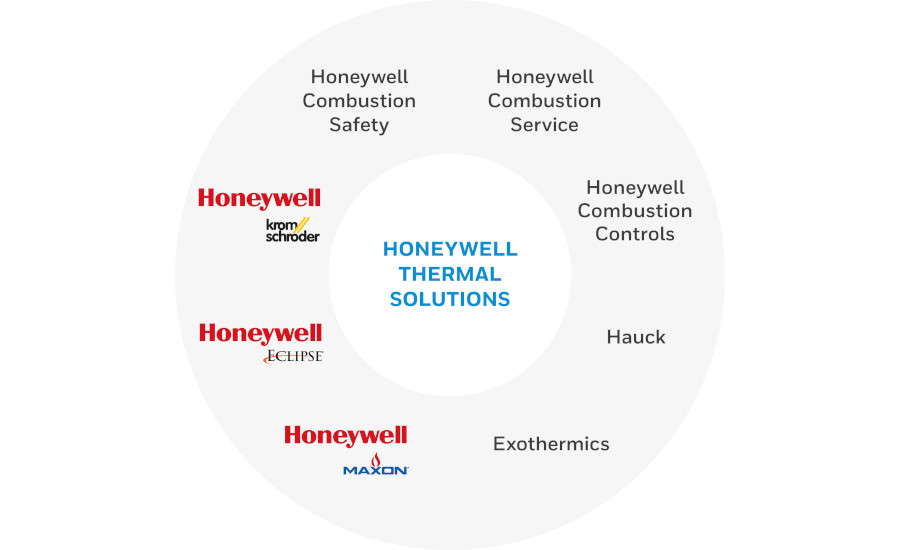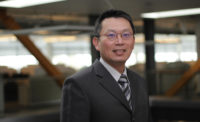Editor’s Note: Every successful project starts with a framework. A vision statement. A blueprint.
The editors of Engineered Systems are proud to introduce The Blueprint — a Q&A interview with HVACR engineering’s leading voices. These one-on-one discussions will examine the trade’s history, current industry trends, and the factors shaping the sector’s future.
On the heels of Honeywell’s Users Group symposium (HUG) in San Antonio — where presenters discussed the tremendous potential of the Industrial Internet of Things (IIoT) to solve the toughest problems facing manufacturers — Honeywell Thermal Solutions appears poised to embrace this digital transformation and continue to stake its place in the global marketplace.
Recently, Tim Lee, vice president and general manager, Honeywell Thermal Solutions, sat down with Engineered Systems editor-in-chief, Herb Woerpel, to discuss HUG, the state of Honeywell Thermal Solutions, the future of the IIoT, how Honeywell Connected Plant leverages IIoT, and more.
Engineered Systems: Can you give me a brief overview of Honeywell Thermal Solutions?
Lee: Honeywell Thermal Solutions is a part of Honeywell Process Solutions. It focuses on industrial and commercial thermal process solutions and has more than 100 years of experience. Two years ago, Honeywell acquired Elster, and with this acquisition, Honeywell Thermal Solutions united some of the combustion industry's leading brands to provide the most extensive range of thermal solutions globally: Honeywell Combustion Controls, Honeywell Combustion Safety, Honeywell Combustion Service, Eclipse, Exothermics, Hauck, Kromschröder, and Maxon. We track 28 different industrial markets that we supply into globally.
Engineered Systems: That’s a lot of moving parts. How do you classify such a large portfolio?
Lee: We’ve broken the portfolio into burners, burner management systems, fuel delivery systems, engineered to order solutions, connected solutions, and control systems. It’s all very wide reaching.
Engineered Systems: Very wide reaching indeed. I saw in a brochure, you do everything from paint drying to making beer bottles to roasting coffee.
Lee: Yes, we roast coffee and make beer bottles. There’s a good chance our thermal process equipment was used in the manufacturing of the clothes you’re wearing or the paint finishing of your car. Our equipment covers thousands of applications, from heavy industrial to commercial.
Engineered Systems: Honeywell Thermal Solutions is growing rather quickly. What’s the catalyst of that growth?
Lee: We’re very busy with acquisitions. It started as Honeywell Commercial Combustion Controls. Then, a little over 10 years ago, Honeywell acquired the Maxon business. Maxon, which is headquartered in Muncie, Indiana, is an industrial combustion company that manufactures burners, shut-off valves, and other engineered solutions. About six years ago, we acquired a brand called Iris. Iris is into high-end flame controllers and flame sensing equipment. About two-and-a-half years ago, the Elster acquisition took place, which brought Eclipse, Hauck, Kromschroeder, Honeywell Combustion Safety, and Exothermics to Honeywell. Mergers and acquisitions continue to be part of Honeywell’s long-term strategy.
Engineered Systems: The recent HUG event focused intently on the IIoT, Honeywell Connected Plant. Can you summarize the imprint Honeywell’s making on this sector?
Lee: Honeywell has deployed the Connected Plant strategy into the marketplace. On top of that, from a combustion standpoint, we’re working on what our connected thermal process strategy looks like and figuring out how that will be carried into the future and what benefits that brings our customer base. Many of our customers no longer have the domain knowledge they used to. They’re looking more and more for third parties to provide that type of service for them. That’s where our connected combustion strategies come into play. We’ll be able to connect the thermal process system to the cloud to be able to give customers more diagnostics and analytics and eventually get to the point where we provide outcome-based solutions and services for our customers.

Engineered Systems: In a survey recently commissioned by Honeywell, two-thirds of respondents believe data analytics can help address important operational issues, such as equipment breakdowns, unplanned downtime, and supply management. At that same time, half of the respondents said they don’t understand the benefits of the industrial IIoT.
Lee: That puts the onus on us to be able to articulate to the market what we mean by IIoT, what exactly our connected strategy entails, and how this all will impact our customers. It’s analogous to when Steve Jobs first came out with the iPhone, and we were introduced to apps. At that time, it was: Why in the world would I need apps on a cellphone. Just a few years later, the world wouldn’t know what to do without them. Many of our customers will look at that and say, I get it a little bit, but what does it really mean? It’s up to us to train, teach, and educate our customers on the evolution of this technology, which is set to take off in the next five years.
Engineered Systems: Which Honeywell products will be central to the industrial IIoT evolution?
Lee: We already have burners, burner management systems, fuel delivery systems, and the engineer-to-order turn-key solutions and services. Now, through our recently introduced Thermal IQ remote monitoring solution, we’re tying all that back into the cloud where customers will be able to set an app on their smart device for each individual combustion application they need to monitor. Is my burner on or off, do I have limits that are functioning properly or not, and eventually, is it running as efficiently as possible? Thermal IQ enables customers to closely monitor their thermal processes, see real-time and trending data, and get alerts when key parameters are outside normal limits at any one moment in time.
Engineered Systems: I can only imagine how our grandfathers would react if we mentioned that one day we’ll be running data analytics on our burners?
Lee: [Laughs] We still have a lot of customers who literally do things using technology that’s 50 years old. As these customers start to retire, they’ll be replaced by people who no longer have that basic knowledge about thermal processes. That’ll certainly be the case when it comes to our old linkage systems and that type of combustion. Not only have BMS systems and ratio control gotten more sophisticated, along with combustion technology itself, but our customers will no longer have that expertise on staff to be able to service their own equipment today let alone optimize it for the future.
Engineered Systems: This, by extension, ties in well to Honeywell’s Engineered to Order service.
Lee: Customers used to just buy component solutions, and they’d build their own complete combustion package. Now, customers are coming to us as they go through their own analysis of what they consider core, what they should keep in house, and what they should outsource. As they’re looking at what’s core to their function. For instance, if you’re roasting coffee, you’re probably an expert at roasting coffee, but you’re likely not an expert in the combustion process it takes to roast that coffee. Therefore, you’re going to look toward third parties to provide that expertise as we go forward.
Engineered Systems: Looking at all the products and services that fall in this umbrella, which have evolved the most over the last two years?
Lee: Without question, our connected strategy. That’s what’s evolved the most. We’re focused on discovering how we can take the data and analytics we already have and put those into a package that provides this valuable data to our customers. The customers can then use that information to drive better outcomes. They can get better quality product more efficiently, use less energy, and optimize their emissions footprint. More and more of our customers may be running factories in a nonattainment area where they don’t need ultra low emission equipment, but they want to be known as a green factory. They want their factory footprints to be virtually identical, no matter where in the world they’re located. They’re using that as a selling feature. They take pride in saying, “We’re green, and this is what we’ve done to be green.” That opens up huge opportunities for us from a combustion standpoint.
Engineered Systems: Is Honeywell approaching the ceiling when it comes to this Connected Plant technology?
Lee: Not at all. We’re just scratching the surface when it comes to the type of analytics and predictive maintenance that are going to be available as we move more toward smart technology within all the individual devices. A shut-off valve will be able to tell you in advance if it’s taking longer to open or longer to close than it’s supposed to. Then you can look at that and trend it over time and go down the road and say, “You’re going to have to service this within the next six months.” Out of that, that will drive service calls, and maybe customers don’t have a qualified service team on staff. They’ll drive us to be able to set up a service call in the future to be able to provide that type of service. From that perspective, we’re just scratching the surface on where this will lead in the future.
Engineered Systems: Through it all, Honeywell is challenged to decipher which analytics make the most sense in each application?
Lee: Yes, we’re responsible for figuring out what kind of analytics we put in place and what kind of software we develop for each of the different pieces of equipment we have. We’ll be monitoring things like airflow, gas flow, and the caloriphic content of the gas itself because gas Btu content is not always the same. Therefore, depending on where the gas is coming from, the Btu value changes, which is going to change the airflow ratio, the efficiency, and the emissions. We’re putting all this together in a package that we can go to our customers and say, “This is what we have to offer that will help optimize your applications.”
 Engineered Systems: Looking at Honeywell Thermal Solutions through a mechanical engineering lens, what do engineers need to be most aware of?
Engineered Systems: Looking at Honeywell Thermal Solutions through a mechanical engineering lens, what do engineers need to be most aware of?
Lee: It’s all about the evolution of the burner technology itself. Burners developed 50 years ago were created at a point in time when no one was as worried about efficiency, and we didn’t care at all about emissions. Now, we’re developing burners that are more efficient, have a lot lower emissions, but as such, they’re all much more sensitive to things like air fuel ratio. We’re also developing how to design burners from an engineering application perspective. If you’re a mechanical engineer working for a company and you’re looking at a burner system, what are some of the things you need to know? How do you apply that burner to get the most efficiency and optimal performance? For example, one of the things you want to drive is temperature uniformity across the entire furnace. What do you need to do from a burner perspective? Where do you need to mount the burners to get that optimal performance? What about the air fuel ratio? If you run excess air, what happens to your emissions? What happens to your efficiency? What is the optimal way to run all of that? As a mechanical engineer, or as a product engineer, working on an industrial combustion-type application, those are the things you’d be asking yourself.
Engineered Systems: This seems like a really exciting time to be a part of the thermal process industry.
Lee: This is a fantastic time to be part of the thermal process business. It’s evolving and changing so rapidly right now with technology. We’ve got technology today through not only software and connectivity but technology within the products themselves. We have smart valves that are able to tell you how they are performing. We’re eventually aiming to place this type of technology directly into the burners themselves. We’ll be able to do air fuel ratio off of just pressure differences. We won’t have to necessarily always have a flow meter depending on the application. These are all technologies we’re developing going forward that really make it an exciting time to be in this business.
I’ve been in this business for almost 30 years. For the first 25 years, this was a relatively stagnant market. From the evolution of product development perspective, what has happened in the last five to 10 years has been phenomenal. Things are happening that we never thought possible. Who would have ever thought you’d have an app on your cellphone that would be able to tell you the exact performance of your thermal process system? What I’ve seen and where we’re going over the next generation is truly phenomenal.






